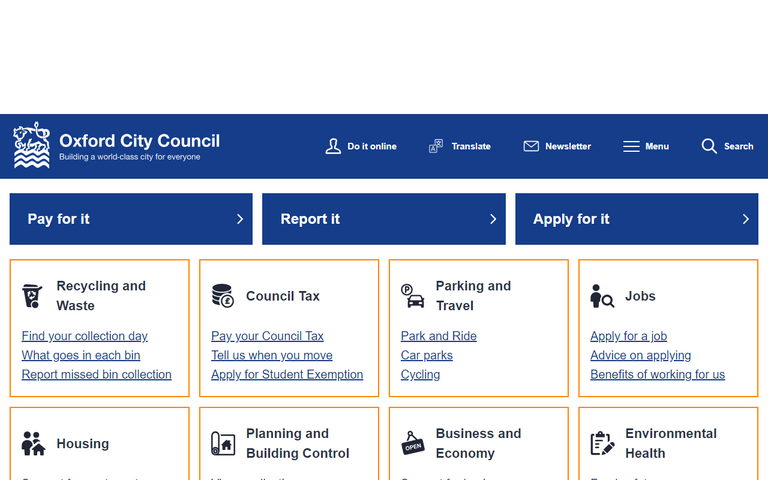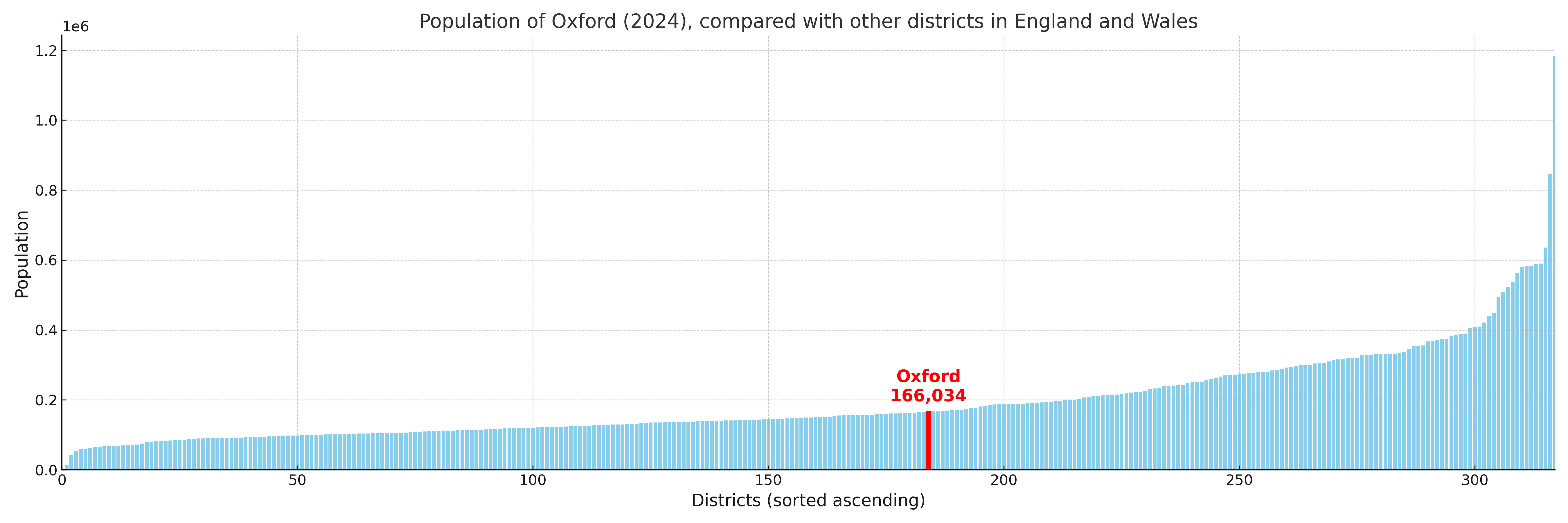Oxford
§ This page gives an overview of the Oxford local authority district, bringing together key facts, maps, and data to help you quickly understand the area. One of 361 district profiles on Baseview.
Overview ⁞ Oxford is a world-famous city in Oxfordshire, renowned for its university, historic architecture, and cultural life. The city centre is dominated by the spires of colleges such as Christ Church, Magdalen, and Radcliffe Camera, set along cobbled streets and quads. The River Thames and River Cherwell weave through, providing meadows and riverside walks such as Port Meadow. Museums, libraries, and theatres add cultural depth, while the city is surrounded by villages and farmland that preserve its rural edges. Its geography blends historic urban life with green landscapes.
Oxford Boundary Map
This map shows the official boundary of the Oxford local authority district, based on the latest geographic data published by the Office for National Statistics (ONS). It provides a clear view of the district’s extent and helps you understand how the area fits within the wider regional and national landscape.
Contains OS data © Crown copyright and database right 2025. Source: Office for National Statistics licensed under the Open Government Licence v3.0.
The administrative boundary of Oxford can also be viewed on OpenStreetMap: District Boundary of Oxford.
Key Facts about Oxford
What region is Oxford in? Oxford is in the South East of England, a region within the UK.
What county is Oxford in? Oxford is located in the county of Oxfordshire.
Is Oxford a city? Yes, Oxford is a city. Oxford holds official city status as one of the 76 designated cities in the UK.
Who governs Oxford? The local authority for this district is: Oxford City Council - responsible for district-level services. Since Oxfordshire is a two-tier area, county-level services are handled by: Oxfordshire County Council.
▶ Official website of Oxford City Council 🔗 oxford.gov.uk

Which police force covers Oxford? Policing in Oxford is provided by Thames Valley Police 🔗 thamesvalley.police.uk, which serves 13 local authority districts: Bracknell Forest ⁞ Buckinghamshire ⁞ Cherwell ⁞ Milton Keynes ⁞ Oxford ⁞ Reading ⁞ Slough ⁞ South Oxfordshire ⁞ Vale of White Horse ⁞ West Berkshire ⁞ West Oxfordshire ⁞ Windsor and Maidenhead ⁞ Wokingham.
Oxford in International Geographies
In the International Territorial Levels (ITLs) hierarchy, Oxford is within one of ITLs Level 2 area, Berkshire, Buckinghamshire and Oxfordshire, that contains the following 5 ITLs Level 3 areas:
(ITL 1) South East
(ITL 2) ⇒ Berkshire, Buckinghamshire and Oxfordshire
(ITL 3) ⇒⇒ Milton Keynes ⁞ Buckinghamshire ⁞ Oxfordshire CC ⁞ Berkshire East ⁞ Berkshire West
The International Territorial Levels are used by OECD member countries for statistical purposes to classify administrative areas. We have this listable page for easy browsing of ITL names and codes: International Territorial Levels.
Constituencies in Oxford
Oxford is divided into 2 parliamentary constituencies, listed below in alphabetical order.
A constituency is a specific geographical area that elects one Member of Parliament (MP) to represent them in the House of Commons. The United Kingdom is divided into 650 parliamentary constituencies. We have this list page for easy browsing of all UK parliamentary constituencies: List of Constituencies.
Wards in Oxford
Oxford is divided into 24 wards, listed below in alphabetical order.
- Barton & Sandhills
- Blackbird Leys
- Carfax & Jericho
- Churchill
- Cowley
- Cutteslowe & Sunnymead
- Donnington
- Headington
- Headington Hill & Northway
- Hinksey Park
- Holywell
- Littlemore
- Lye Valley
- Marston
- Northfield Brook
- Osney & St Thomas
- Quarry & Risinghurst
- Rose Hill & Iffley
- St Clement's
- St Mary's
- Summertown
- Temple Cowley
- Walton Manor
- Wolvercote
In the UK, a ward is a subdivision of a local authority area, used mainly for electoral and statistical purposes. Defined by the ONS, wards represent the primary unit for local elections, each returning one or more councillors to the local council. Wards are also used as a key geography for presenting population and census data.
Parishes in Oxford
Oxford is part-parished: 4 civil parishes (listed A-Z below) alongside 2 unparished areas.
- Blackbird Leys
- Littlemore
- Old Marston
- Risinghurst and Sandhills
A civil parish is the lowest tier of local government in England, used for villages, small towns, and suburbs. They have their own local authority, either a parish council or a parish meeting, which provides local services like managing parks, allotments, and streetlights, and represents the community's views to larger councils.
Built-up Areas in Oxford
Oxford covers 2 built-up areas, listed below in alphabetical order.
- Oxford *
- Wolvercote
In the UK, a Built-up Area (BUA) is a continuous urban area of at least 20 hectares (0.2 km²), defined by the ONS as land where buildings are generally no more than 200 metres apart, such as towns, cities, or large villages. (Note: A BUA name marked with an asterisk (*) indicates that the area is situated partly in the district of Oxford.)
Oxford compared with other districts in the UK
This section shows how Oxford compares with other local authority districts in the UK, using a variety of measures and rankings.
Oxford has 24 electoral wards.

Oxford has a population of 166,034 (2024 mid-year estimate by ONS)

More local statistics and data for Oxford can be found on the ONS statistics for Oxford.